
Ignoring customer success metrics is like navigating a ship without a compass. These key performance indicators (KPIs) provide a pulse on the health of your customer relationships and offer a roadmap to improving your products or services.
Customer success has become a red-hot topic. Among companies with over 500 employees, 82% choose to use customer success platforms.
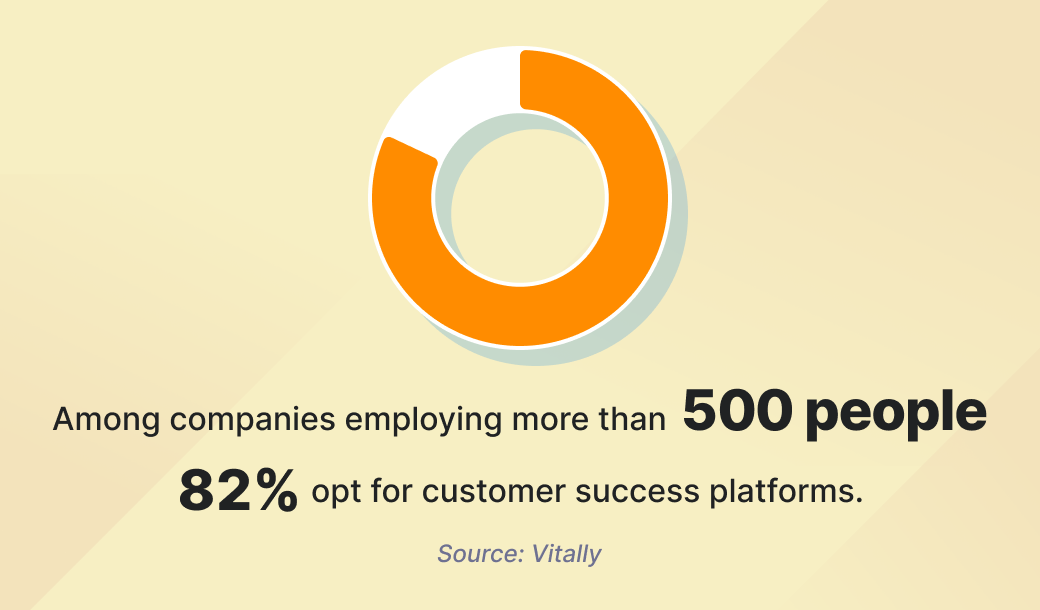
In this article, we will touch upon the 15 most crucial customer success metrics your business should track. We’ve also thrown in some customer success metrics SaaS (software as a service) businesses like us should measure to assess performance.
Let’s start with the fundamental question…
What are customer success metrics?
Customer success KPIs are the quantitative expressions of the customer’s progress in adopting and using a product and recommending it to other potential users. Customer metrics are indicative of the performance of the customer success team and the efficiency of your customer contact and support channels.
They can provide valuable insights into critical areas like customer journey, support quality, satisfaction, and more. They are organized into two major categories, both equally important:
- KPIs to measure customer success, support, and engagement
- KPIs to measure business health and revenue
Infographic: Top 15 customer service metrics
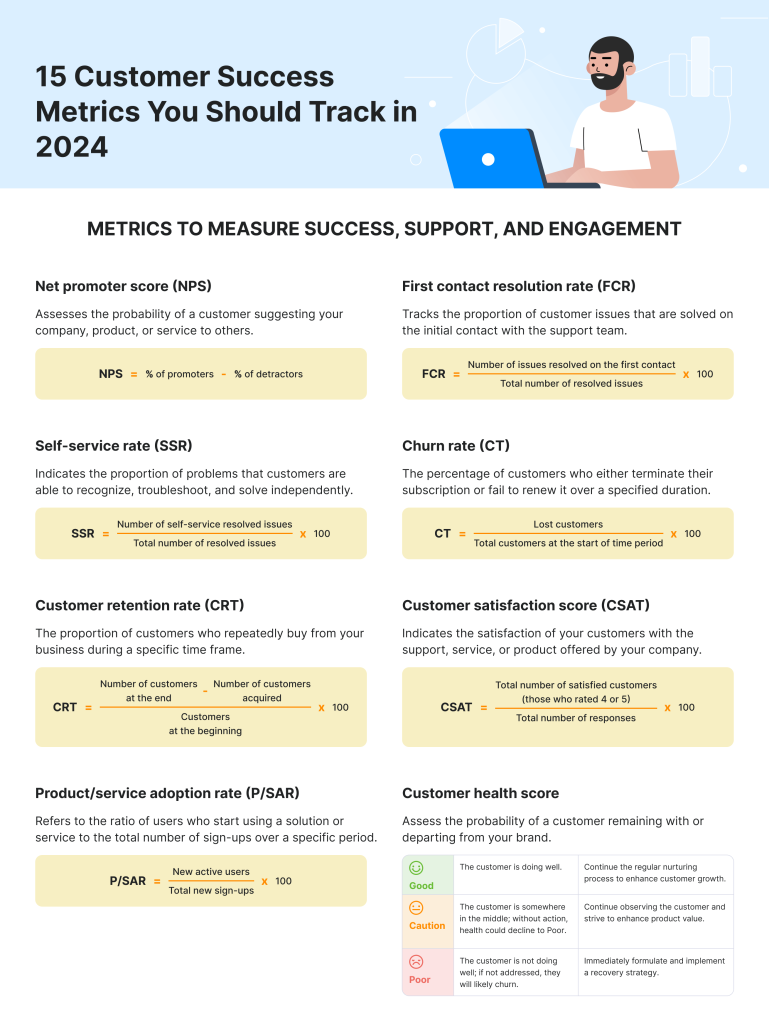
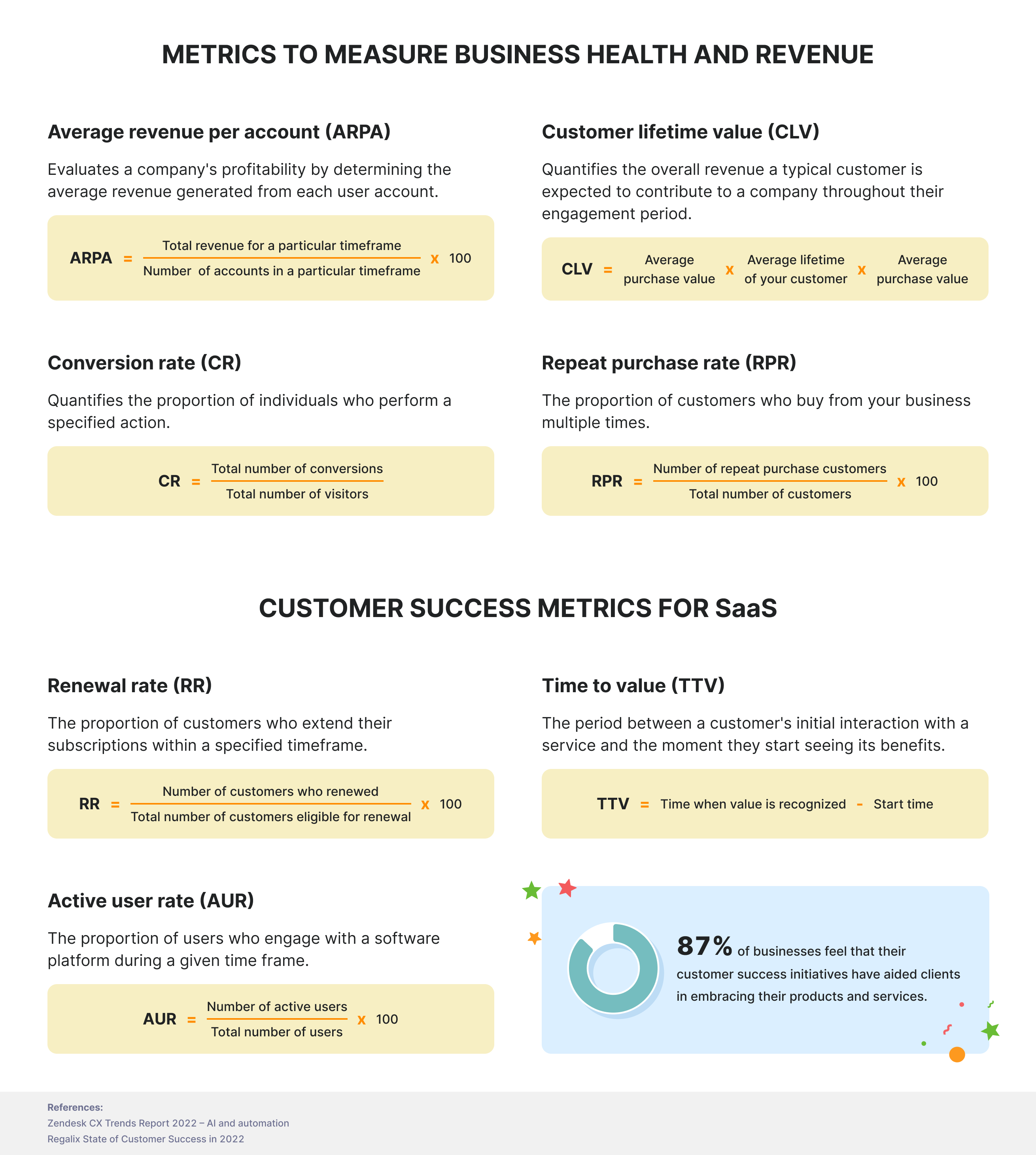
📥 Feel free to download and share this infographic from this Figma link.
Metrics to measure success, support, and engagement
1. Net promoter score (NPS)
NPS is a leading indicator of future growth, creating a feedback loop between your customers and business. With it, you can find out how satisfied your customers are with your company, products, and services. This gives you valuable insight into what areas need improvement to enhance customer satisfaction.
Why is NPS important?
NPS is a leading indicator of future growth, creating a feedback loop between your customers and business. With it, you can find out how satisfied your customers are with your company, products, and services. This gives you valuable insight into what areas need improvement to enhance customer satisfaction.
How to calculate NPS
To calculate your net promoter score, ask your customers: “How likely are you to recommend [your business/product] to a friend or colleague?” Then, assign each response on a scale from 0-10. Based on the respondents’ answers, they fall into three categories.
- Detractors: Customers that give ratings between 0 and 6. These customers are less likely to buy from you again and more likely to tell others that they’re unhappy with your brand.
- Passives are customers who rate their experience between 7 and 8. They are satisfied but have yet to be thrilled with your offering. If given an attractive offer, passives may be open to buying from someone else.
- Promoters: Customers that provide ratings between 9 and 10. These are your most valuable customers, loyal advocates who will share their positive experiences with others.
To calculate the NPS, subtract the percentage of detractors from the percentage of promoters.

The results vary between -100 and 100, so don’t panic if your NPS is negative. It’s not a disaster but a call for prompt attention and response from your side.
This is where our free NPS calculator comes in handy. It allows you to summarize the results quickly and easily and get your net promoter score.
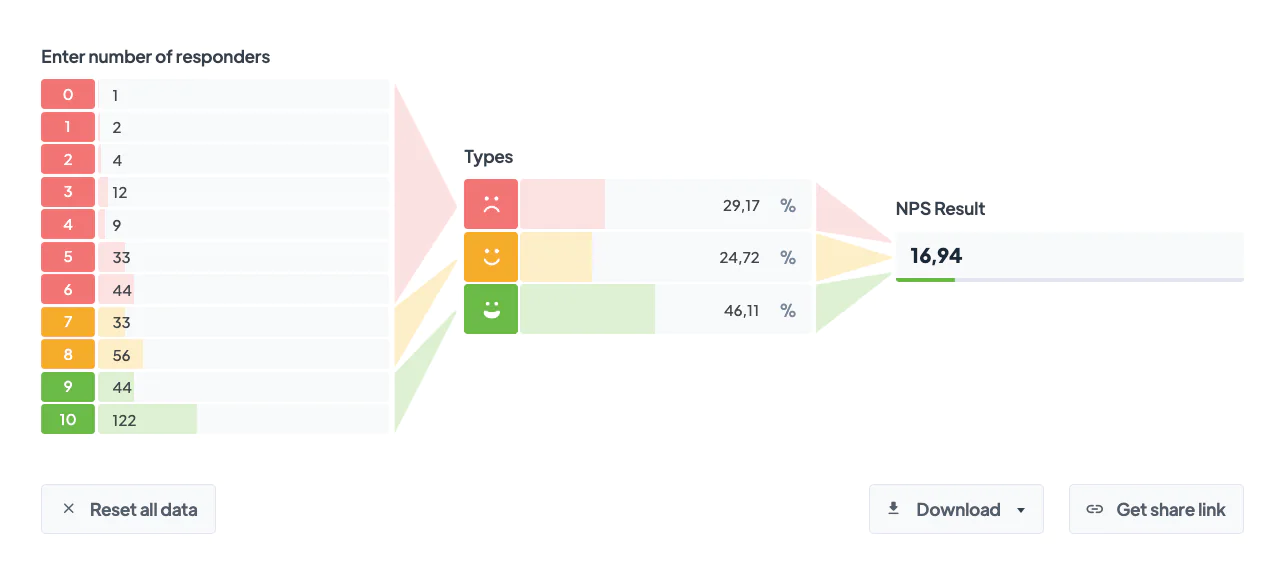
📊 Remember that an NPS greater than zero is acceptable. An NPS over 30 is great and one beyond 50 is amazing. Anything above 71 is absolutely outstanding but hardly attainable.
2. Customer satisfaction (CSAT) score
The customer satisfaction score measures customer satisfaction with your product and brand. It’s one of the most direct and reliable indicators of a company’s performance and can be used to measure specific interactions.
A high CSAT score presupposes high customer loyalty and, thus, an opportunity for further customer acquisition.
Why is the CSAT score important?
CSAT has been shown to directly affect revenue growth, making it one of the critical customer success metrics for businesses to track. Generally, it involves two aspects – your product and your support.
A study by Khoros shows that 83% of buyers consider good customer service their most important criterion when purchasing. And over 65% of customers who experience poor service will not engage with that brand again.
Knowing your CSAT score will help you identify your weaknesses and improve your business processes.
How to calculate customer satisfaction score
The first step to calculate your CSAT score is to create a survey asking customers how satisfied they are with your products or services. We recommend asking customers to answer questions on a scale of 1 to 5 (1 being very unsatisfied and 5 being very satisfied).
Once you have collected data from your survey, take the number of customers that rated you 4 or 5 and divide that by the total number of responses.

📊 According to the American Customer Satisfaction Index (ACSI), a good CSAT score varies between 73% and 77%. So, when tracking this metric, ensure your score is in this range.
3. Customer health score
The customer health score is a customer support metric that measures the likelihood that a customer will continue using your products/services or leave your brand. You can use it to track the risk of losing your customers and see if there’s anything you can do to improve their experience.
Why is customer health score important?
Customer health score allows you to understand which customers are likely to churn. Equipped with this information, your account managers and customer service teams can take action before that happens.
How to calculate the customer health score?
1. Decide what you want to accomplish. Do you want to have more loyal customers who will stay longer? Or do you want to reduce churn by 10% in six months? Once you specify your goal, you can decide which customer success KPIs will help you achieve it.
2. Select the metrics you’ll use to evaluate customer success. Here are some examples of customer behavior metrics for measuring the customer health score:
- Duration of the customer relationship
- Product usage (taking into account the depth and breadth of usage)
- Customer support tickets or cases
- Product upgrades/renewals
- Marketing engagement
- Customer feedback
3. Set up a scoring system to measure how healthy your customers are. For example, add points to a customer’s overall score if they contact your team frequently. Reduce points if a customer submits negative feedback.
4. Visualize the health score of your customers. This will let anyone on your team see how a particular client is doing. There are different types of scoring systems you can use:
- Color code
- Percentage scale
- Alphabetical scale
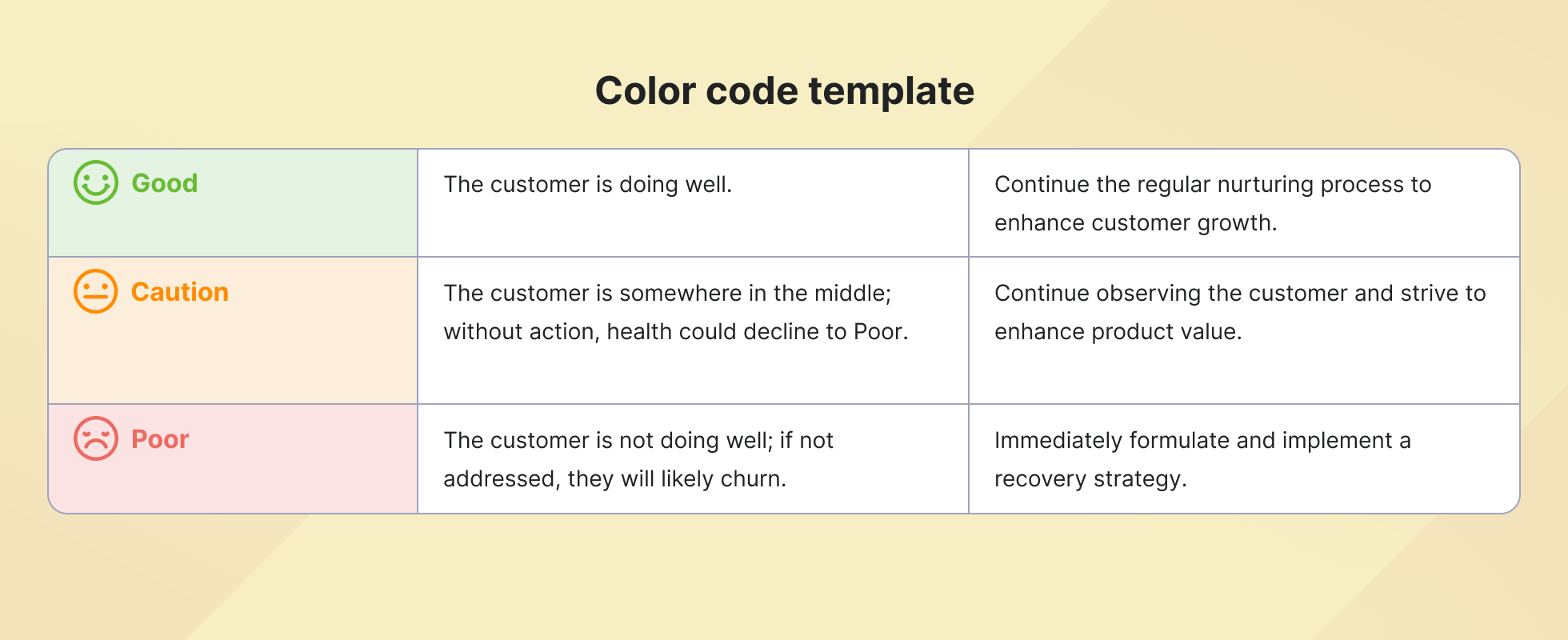
☝ Note that not all health scores are of equal importance and weight. This is something you should consider when calculating the global health score.
4. First contact resolution (FCR) rate
The first contact resolution rate (FCR) is an essential metric for the number of customer issues resolved during the first interaction with the support team.
Why is FCR important?
Resolving a problem on the first contact is the ideal customer service scenario because it eliminates the need for follow-up for both sides. This positively impacts your customers and support staff, freeing the latter to serve even more clients.
A high FCR generally translates into customer satisfaction and better retention. And it’s long established that retaining customers brings considerable savings from acquiring new ones.
How to calculate the FCR rate?
Divide the number of cases resolved on the first contact by the total number of issues handled by agents. To get the corresponding percentage, multiply the quotient by 100.

📊 For example, if 200 out of 500 customer issues are resolved on the first contact, the FCR rate is 40%, which is considered low. Although it depends on the particular niche, FCR rates of about 75% are generally accepted as satisfactory, and FCR rates of around 90% are considered high.
5. Self-service rate
Self-service rate, or self-service success rate, indicates the percentage of issues that customers can identify, diagnose, and resolve on their own without contacting a support agent.
Why is the self-service success rate important?
The self-service rate is particularly indicative of the effectiveness of your customer support. The figure shows how well your customer success managers adapt to modern support trends. The higher the self-service rate, the better chances you give your customers to educate themselves about your products or services.
Not only does a high self-service rate improve customer experiences with your brand, but it also means savings in terms of the time your support team invests in dealing with less complex issues.
Customer contact channels such as social media or self-serve portals, which include frequently asked questions and knowledge bases, can help you quickly increase the self-service rate.
How to calculate the self-service success rate
This customer metric can be calculated as the ratio of the number of issues users deal with without the help of a live support agent and the total number of issues, including those handled by the support team for a particular time frame.

🧮 Imagine 200 users forgot their passwords for an application and were locked out of their accounts. If 150 of them recover or change their passwords on their own by using the user guides provided in the app, the self-service rate is 75%.
6. Churn rate
Customer churn rate is the percentage of customers who cancel a subscription or don’t renew it for a given period of time. A low customer churn rate means that most of your customers are paying for your product or service.
On the other hand, a high churn rate means that customers are leaving in droves and canceling their subscriptions at an alarming pace.
Why is churn rate important?
The customer churn rate shows how well your company retains customers over time. What’s more, it helps you:
- Identify and predict the risk of losing customers
- Determine which products or services are at the greatest risk
- Improve customer retention
- Build better relationships with your customers
Stefan Chekanov, CEO at Brosix, explains how essential it is to keep a close eye on the customer churn rate:
“As a subscription-based business that relies on customer retention for recurring revenue, measuring our churn rate is critical for us. From our perspective, for every customer lost, the situation indicates some form of problem either with our product or with our marketing efforts. We aim to use as much information as possible from our churned customers to identify our weaknesses, while also making every effort to retain them. This creates a type of feedback loop that we use for continuous progress. While some churn is healthy, our aim is to keep the metric as low as possible by focusing on boosting customer satisfaction from every possible angle.”
How to calculate customer churn rate
The customer churn rate formula is:

Let’s say your company had 500 customers at the beginning of the month. By the end of the month, you had lost 5 customers. Divide 5 by 500 to get 0.01. Multiplying 0.01 by 100 gives a monthly churn of 1%.
If this sounds too complicated, there’s a quicker way to calculate your churn rate. Use our churn rate calculator to get faster results and easier-to-understand reporting.
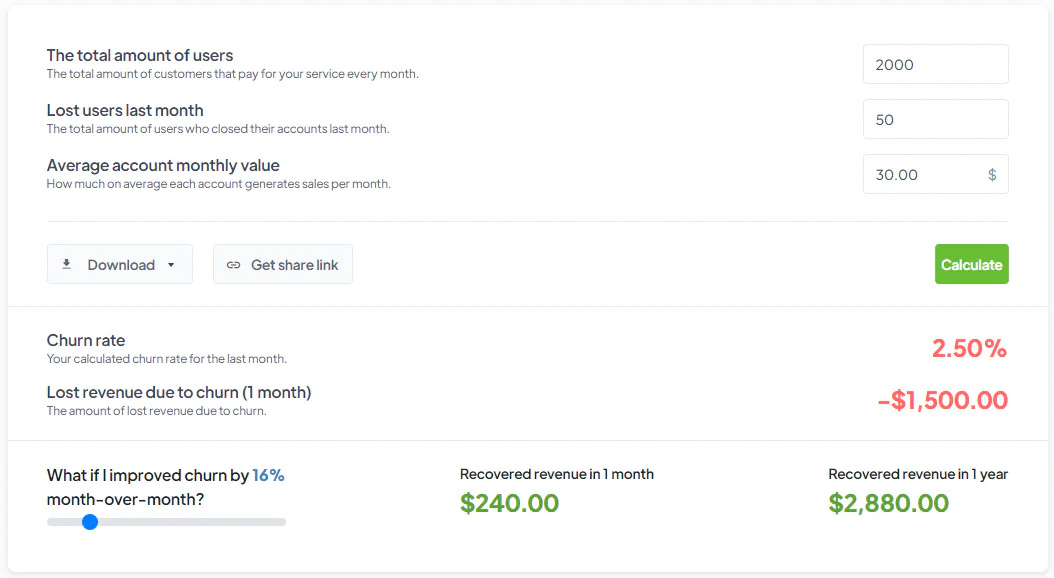
📊 With these details in mind, your next question may be, what is a reasonable customer churn rate? While there’s no one-size-fits-all standard, a churn rate between 3% and 5% monthly is considered healthy.
7. Customer retention rate
Customer retention rate is the percentage of customers who continue to purchase from a company over a particular period. It’s among the most important customer success criteria that you can use to assess your company’s performance and track its progress over time.
Why is customer retention rate important?
As a business owner, you know that repeat customers are the lifeblood of your business. One of the most obvious benefits is that your business will continue to thrive and grow. Did you know that 52% of customers express brand loyalty through recommendations to friends and family?
Also, the cost of acquiring a first-time buyer is 5 times higher than the cost of retaining a repeat one. All these figures point to the great importance of customer retention as a marketing strategy and a KPI to keep an eye on.
How to calculate customer retention rate
Here’s the formula:

Start by calculating the number of customers you have at the end of the period (E). Deduct the number of new customers acquired during the period (N) and divide the result by the number of customers at the beginning of the period (S). Finally, multiply the result by 100 to get your customer retention rate in percentage.
🧮 For instance, let’s say you have 25 customers at the beginning of the year, gain 10 new customers in the first half, and have 4 customer churns. Your retention rate will be [(31 – 10)/25] x 100 = 84%.
8. Product or service adoption rate
Product or service adoption rate is the number of subscribers implementing a solution or a service versus the total number of signups within a set timeframe.
This is one of the key customer success metrics SaaS companies use to get valuable insights into the quality of their products and the effectiveness of their support teams.
Why is product adoption rate important?
This rate clearly indicates the effectiveness of the engagement and retention of the users you acquire. It also provides insights into the number of new subscribers you lose so you can adjust your interactions and engagement strategies accordingly.
How to measure product adoption rate

🧮 If you have 50 newly subscribed users this week, and 5 of them have become active users of your product or service, your adoption rate is 10%. You can calculate it daily, weekly, monthly, quarterly, or yearly.
Metrics to measure business health and revenue
9. Average revenue per account (ARPA)
ARPA measures a company’s profitability and identifies the average revenue per user account. ARPA (or ARPU) can be measured over different periods – monthly or yearly.
Why is average revenue per account important?
ARPA is an essential profitability metric, particularly for subscription-based services. It’s used to forecast predictable revenue and future growth.
Also, it’s applied when analyzing and segmenting subscribers to identify the best products or services. Therefore, ARPA provides valuable insights that can help you keep track of your company’s performance and profits and identify your strengths and weaknesses.
How to calculate average revenue per account
To determine ARPA for a given period, you have to divide the company’s revenue for the time frame considered by the number of accounts for the same timeframe.

🧮 For example, if you have a monthly recurring revenue of $33,000 and 11 subscribers, your ARPA is $3,000.
10. Customer lifetime value (CLV)
Customer lifetime value measures the total revenue a company can generate from a typical customer over the period they remain active with a company.
To maximize CLV, you should understand what drives customer retention and loyalty so you can use this data and deliver better experiences.
Why is CLV important?
Your total CLV determines your profitability and translates into a steady cash flow. It also provides a reliable basis for planning your budgets and campaigns.
CLV indicates how much your customers are spending now and how much they will spend in the future. Without this information, your planning is based on guesswork.
How to calculate CLV
You can calculate CLV by multiplying the average purchase value of your customers, the average purchase frequency, and the average lifetime of your customers.

📱 You can also use our CLV calculator to get faster results and vital insights into your company’s customer base.
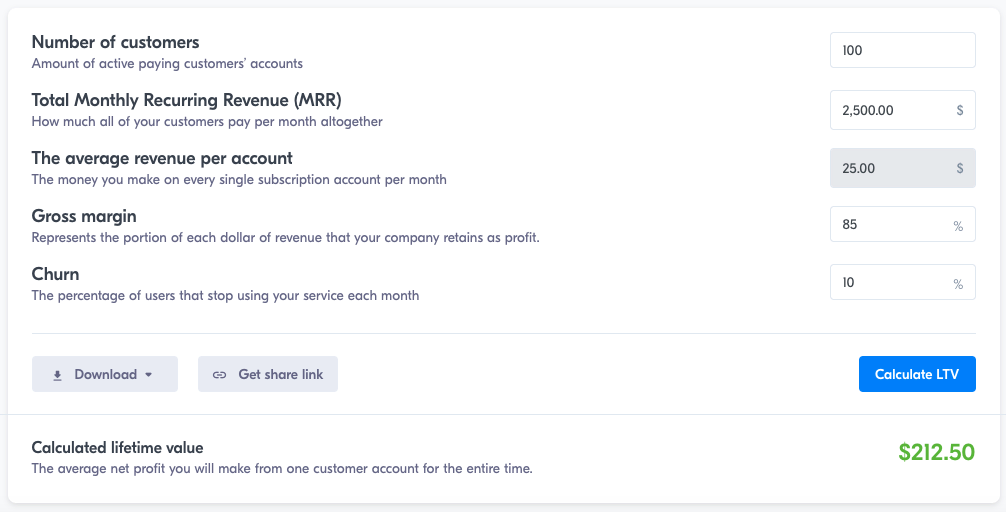
11. Conversion rate
Conversion rate is a percentage that measures the number of people who take a desired action, such as buying a product or signing up for an email list. It’s one of the most important metrics for measuring your marketing success and effectiveness.
Why is conversion rate important?
Conversion rate indicates how well your marketing campaigns are performing. A sign of successful marketing is a high conversion rate which translates into more sales and revenue.
How to measure conversion rate
You can calculate the conversion rate by dividing the number of conversions during a given period by the total number of interactions with your website/ads. And to get your conversion rate in percent, multiply the result by 100.

📊 Let’s say you have a website with 1,000 visitors per month, and only 5 people purchase your product monthly. Your conversion rate would be 0.5% which is considered low. When tracking customer success metrics, you should aim for a conversion rate between 2.7% and 4.4%.
12. Repeat purchase rate
The repeat purchase rate is the percentage of customers that purchase from a company more than once. Actually, this is the ratio of returning buyers against the total number of customers. The higher your repeat purchase rate, the more loyal customers your brand has.
Why is repeat purchase rate important?
On average, returning customers spend 67% more than new ones. Therefore, keeping an eye on your repeat purchase rate is crucial.
How to measure repeat purchase rate
The repeat purchase rate is calculated by dividing the number of customers that have made a repeat purchase by the total number of customers. The percentage figure is obtained by multiplying the result by 100:

📊 The commonly accepted figure of a good repeat purchase rate depends on the particular company and industry. The benchmark for eCommerce, for example, is 25-30%.
Customer success metrics for SaaS
We asked Aleksandra Lemzyakova, our head of customer support, to share a few words on why it’s so important to track the right SaaS success metrics:
“Effective tracking of customer success metrics is crucial for SaaS business growth. It’s not merely about observing numbers; it’s about understanding the story behind each user interaction and engagement. These metrics guide us to improve and tailor our services, driving customer satisfaction and retention. By focusing on what truly matters to our users, we turn them into brand champions. In essence, their success is our success.”
Here are some customer success metrics SaaS companies (ourselves included) should pay close attention to.
13. Renewal rate
The renewal rate refers to the percentage of customers who renew their subscriptions over a given period. It indicates their satisfaction and willingness to continue using the service.
Why is renewal rate important?
Think of it as the loyalty meter for your SaaS. It’s meant to measure the long-term success of your service.
How to calculate the renewal rate?
Find out how many customers renewed their subscriptions during a set timeframe. Then, divide this figure by the total number of customers eligible for renewal in that period. Multiply the outcome by 100 to obtain the renewal rate as a percentage.

🧮 For example, if you had 500 customers eligible for renewal and 450 of them renewed, the renewal rate would be (450/500) x 100 = 90%.
14. Time to value
Understanding how quickly customers recognize the value of a service is vital. Time to value measures the duration from when customers engage with the service to when they start seeing its benefits.
Why is time to value important?
Well, the quicker customers see results, the happier they are. Therefore, they are more likely to stick around. The time to value metric directly correlates with customer retention.
How to measure time to value
Identify the specific actions or touchpoints marking the customer’s initial engagement with your service. Then, determine the point at which the customer begins to experience tangible value or benefits from their interaction.

🗓️ For example, if a customer signs up for a software subscription on January 1st and begins using its advanced features on January 15th, the time to value would be 14 days.
15. Active user rate
The active user rate indicates the level of utilization of a software platform over a specified period. It can be assessed daily, weekly, or monthly.
Why is the active user rate important?
The active user rate helps SaaS companies see if users actively engage with their services. If the active user rate is low, it could mean that users don’t find the software helpful or easy to use. On the other hand, a high active user rate suggests strong engagement and satisfaction.
How to calculate active user rate
Identify the specific criteria that define an “active user” based on their interactions with the platform. Then, calculate the percentage of users who meet these criteria within the designated time frame.

🧮 For example, a software platform has 1,000 registered users. 600 of them have logged in and performed actions within the past 30 days. Therefore, the active user rate is 60%.
Focus on the right customer success metrics
Customer success is a broad term that encompasses all the elements of an outstanding brand experience—from the first interaction to repeat purchases and loyalty.
Track your customers’ overall health and analyze their interactions or important milestones to bring about positive changes. One metric at a time.
Frequently Asked Questions (FAQs)
Customer success metrics help businesses measure how well they are delivering value to their customers. These metrics—such as churn rate, Net Promoter Score (NPS), and customer lifetime value—are critical for improving retention, satisfaction, and long-term growth.
Yes. Textmagic enables you to set up automated SMS campaigns, follow-ups, and reminders to proactively engage customers. Timely communication helps reduce churn by improving satisfaction, supporting onboarding, and keeping users informed throughout their journey.
Tools like NPS (Net Promoter Score) and CSAT (Customer Satisfaction Score) are widely used. You can measure these by sending short, focused surveys via SMS or email. Textmagic lets you do this quickly with bulk texting and survey distribution features.
With Textmagic, you can track message delivery status, response rates, and click-throughs on short links, helping you measure engagement in real time. This visibility allows teams to identify which messages resonate and optimize outreach accordingly.
For SaaS, key customer success metrics include churn rate, product adoption, and customer lifetime value (CLV). These help measure how effectively users are realizing value and whether they’re likely to remain loyal.
Related articles
20 Contact segmentation ideas to save hours on follow-ups
Segments in Textmagic help you skip the repetitive w...
SlickText vs. Textmagic: What you need to know before you choose
Choosing the right SMS marketing platform can signif...
Mailchimp vs. Textmagic: Features, pricing, and use cases explained
When it comes to reaching audiences properly, it’s n...
How to elevate customer service through automated email responses
Check out the best practices for automating support ...
62 Customer service email templates for every situation
Clients expect fast and reliable service that meets ...




